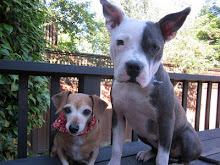Saturday, June 30, 2012
A Vet's List Of Top Poisons The Affect City Dogs
Top Poisons Plaguing City Dogs
By Sarah Hughes, DVM
Toxic ingestions account for a significant portion of the cases seen in animal emergency rooms. Our canine companions are regularly exposed to the foods we eat, the drugs we take, and the chemicals we bring into our homes, garages, and yards. Following are some of the most common toxicities we see in the urban (vs. rural) veterinary emergency department:
Rat poison
Rat bait ingestions cause life-threatening changes in our pets. If caught within a few hours, treatment can be relatively straightforward and may have a good outcome. If not caught immediately, rat bait ingestion can be critical, and the outcome is far more grave. If you notice or suspect rat poison ingestion, immediately take your pet to the closest emergency room. Bring along the substance and its packaging. There are several types of rat poison that work in different ways, and each type is treated differently.
Antidepressant medications, amphetamines, and other medications
Ingestion of these substances can cause “Serotonin Syndrome,” in which serotonin receptors are overstimulated. Signs include mental abnormalities, vomiting, difficulty breathing, drooling, seizures, arrhythmias, and tremors. Usually these reactions begin within minutes and can progress to death within a few hours. Seek immediate veterinary care, as early treatment improves the prognosis.
Grapes/raisins, onions, and xylitol
Raisin/grape toxicity can cause acute kidney failure in dogs. Vomiting is the most common initial sign. Onions (along with leeks, shallots, and garlic) can damage our pets’ red blood cells. Xylitol, a commonly used sweetener in gum, toothpaste, etc., causes low blood sugar, liver failure, and abnormal coagulation.
Non-steroidal anti-inflammatories (NSAIDs)
Ingestion of these common over-the-counter medications can threaten many interior organs, including the liver, kidneys, and intestines. NSAIDs produced for both human and animal use can be toxic. If you believe your pet has ingested such medication, try to establish how much and at what time, and take along the pill container with you and your pet to the veterinary hospital.
Chocolate and coffee
While humans can savor a chocolate dessert or a morning coffee without worry, our companion animals cannot. In addition to chocolate, caffeine stimulants, energy boosters, and cocoa bean mulch contain theobromine and caffeine, which adversely affect the central nervous system, gastrointestinal tract, heart, and kidneys in dogs. The darker the chocolate, the greater potential for serious problems, including death.
Marijuana
Signs of marijuana ingestion in dogs include lethargy and incoordination, as it affects the brain. It is possible for pets to consume toxic doses, so do not delay treatment.
Antifreeze
Though it is colorless, odorless, and sweet-tasting, ethylene glycol (antifreeze) is a serious toxin. Even in small doses, it can cause severe kidney damage. According to the American Association of Poison Control Centers, ethylene glycol ingestion in animals is the second most common cause of fatal poisoning, but prognosis for recovery can be good if treated soon. This is a serious medical emergency!
Tremorgenic mycotoxins (found in spoiled food) or metaldehyde (slug bait)
Sometimes people do not think of mycotoxins in an urban setting, but a dog with dietary indiscretion and access to the compost pile may be at risk. Clinical signs are mostly anxiety, restlessness, and tremors and can progress to more serious neurologic signs. Slug bait can be toxic to animals though skin contact, inhalation, and ingestion. Early and aggressive treatment is needed for a favorable recovery.
Warning: You may have heard about using hydrogen peroxide to induce vomiting at home as a way to deal with poisons, but this is not always recommended. Your pet should first see a veterinarian to assess if it is safe for the pet to vomit up the toxicant and to determine if vomiting is appropriate for a particular toxin (sometimes it causes even more damage)
In the event that you notice your pet eating something he/she shouldn’t, or if you aren’t sure, do not hesitate to call your regular veterinarian or the closest emergency clinic. Be prepared to discuss what, when, and how much your dog ate. Any information you can provide (including labels/packaging) will be helpful.
Depending on the situation, your veterinarian may recommend that you bring your pet in immediately, carefully monitor your pet at home, or call the National Animal Poison Control Center. The NAPCC is a call center staffed with veterinarians who have additional training in toxicology. They are available 24/7 to answer calls about any potential toxin ingestion by pets. The phone number is 888-426-4435. Please post it in a prominent place. You never know when it may be a life-saving phone call.
Sarah Hughes, DVM, is part of the 2011- 2012 intern class at VCA San Francisco Veterinary Specialists. She received a B.S. in animal science and her DVM from the University of Illinois at Champaign-Urbana. This article is based on a continuing education lecture presented by Heidi Houchen, DVM, VCA Northwest Veterinary Specialists, in February 2012. It appeared in the June 2012 issue of Bay Woof featuring Oscar the Dachshund, shown above.
Subscribe to:
Post Comments (Atom)





1 comment:
Animal care center in MO, Ballwin provides the highest quality services with the least amount of stress to the pet owners.
Post a Comment